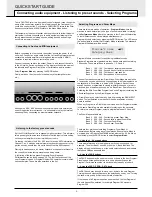
Memories
The first generation of synthesizers, produced many years ago were large
modular machines where each part of the synthesizer was housed in a
separate unit (block). These blocks could only be physically connected
together by combinations of cables known as patch leads. A typical sound
produced by this method would often involve connecting dozens of patch
leads.
Every time a new sound was required, the leads would have to be physi-
cally disconnected and reconnected. The positions and connections of the
leads would have to be noted down on paper if there was to be any hope
of creating that particular sound ever again ! If not reconnected in exactly
the same way, the sound would be lost forever.
Modern machines such as the KS 4 / KS 5 have all the blocks in one
compact unit and the sound generating or modifying blocks are arranged
in a sensible fashion. Front panel switches and knobs determine how
each block functions and where the sound modifying blocks such as the
LFOs and Envelopes are routed, instead of having to physically connect
them externally with cables.
Additionally, The settings of these front panel controls (which of course
determine the current sound or ‘patch’) may then be stored in memory
locations in the machine which can be recalled at any time.
Summary
An Analogue synthesizer can be broken down into five main sound gener-
ating or sound modifying (modulating) blocks.
1
Oscillators that generate Waveforms at a certain
pitches.
2
A Mixer that mixes the outputs from the Oscillators
together.
3
A Filter that removes certain harmonics, which changes
the characteristic or timbre of the sound.
4
An Amplifier that is controlled by an Envelope
generator. This alters the volume of a sound over
time when a note is played.
5
LFOs and Envelopes that can be used to modulate
any of the above.
Much of the enjoyment to be had with a Synthesizer is with experimenting
with the factory preset sounds and creating new ones. There is no substi-
tute for ‘hands on‘ experience. Experiments with altering knobs and
switches will eventually lead to a fuller understanding of how the various
controls alter and help shape new sounds.
Armed with the knowledge in this chapter, and an understanding of what
is actually happening in the machine when tweaks to the knobs and
switches are made, the process of creating new and exciting sounds will
become easy - Have fun.
SYNTHESIS TUTORIAL
Memories - Summary
•
14
•









































